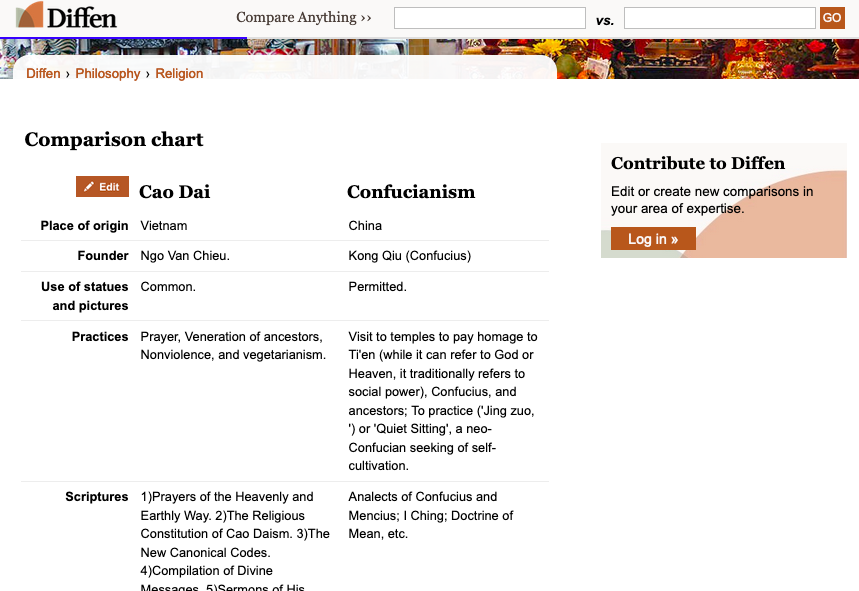Someone in our congregation pointed me to diffen.com, which says it will et you “Compare anything.” Want to compare the first generation Apple TV remote with the second generation version? Diffen has got you covered. My informant said that Diffen also has a religion category, so of course I had to check it out.
Diffen’s comparisons of religion would have gone well back in the 1960s, when we were beginning to understand that there was a great big world out there but we still unquestioningly accepted a world view centered on Europe and the United States. (A less polite way of saying this is that Diffen is about fifty years behind the current state of religious studies scholarship.) Yet Diffen’s understanding of religion is probably similar to that of the majority of Americans and Europeans. In other words, Diffen probably represents an accurate picture of pop culture notions of religion.
Let’s take one of their comparisons between two religions and pick it apart. Let’s click on Cao Dai vs. Confucianism.

“Place of origin” seems pretty straightforward, right? Clearly, Cao Dai originated in Vietnam, and Confucianism originated in China. Well, sort of. It might be more accurate to say that Cao Dai began in French Indochina; yes, that’s Vietnam, but Cao Dai emerged partly in response to colonial oppression. As for Confucianism arising in China, there was no nation known as “China” when Confucianism began, and indeed the teachings of Kongzi (“Master Kong,” i.e. Confucius) were often a direct response to the political situation of the Spring and Autumn period of the Eastern Zhou empire. Imperial China arose several hundred years after Kongzi lived, during the Qin dynasty.
Emphasizing the historical nature of religion is not mere nitpicking. One of the key goals of religious literacy, according to the American Academy of Religion, is helping people understand that religions change over time. With its simplistic category of “Place of origin,” Diffen removes historical nuance and may even lull you into thinking that religion is some timeless thing outside of history.
Later we come to “Use of statues and pictures.” Maybe Diffen thinks its intended audience isn’t smart enough to understand a term like “material culture.” But to me this feels like another instance of Western bias. We Westerners are still concerned with the split between Protestants and Catholics. We still think it’s important to know if a religion uses a lot of statues and pictures, because we want to know if that religion is more like Catholicism or Protestantism. But a more fruitful, and more nuanced, line of inquiry is to ask about the material culture of a religion. What physical objects are important to the religion? How are physical objects used by the religion?
You see attempts at nuance as you go down the list of comparisons between Cao Dai and Confucianism. There’s an item asking for a comparison of “Concept of Deity,” and under Confucianism it says, “Most [adherents] believe in One God, but this is not necessary since Confucianism is not a religion but a belief system about social ordering.” Whoever wrote this at least understands that Confucianism doesn’t fit well into the Western category of religion; whoever wrote this also understands that there’s at least some internal diversity within Confucianism. But once again Confucianism is reduced to some kind of simplistic East Asian Christianity. The underlying problem here is Diffen assuming that the way you must compare religions is to compare the “Concept of Deity” — given their Western bias, they obviously assume that all religions must have a concept of a deity. And indeed, a little further down the list, Diffen asks for a comparison of “Concept of God.” Because if it’s a religion, it must have a God (capitalized and singular).
I’m trying to be kind to Diffen. But — wow, I thought Wikipedia’s articles on religion have problems, but Diffen is unbelievably bad.
I don’t think the problem lies in Diffen, though. I think the problem lies in the religious illiteracy of Western culture. Most college graduates haven’t reached the basic, low-level standards for religious literacy established by the American Academy of Religion (more about those standards here). Many Americans are actually proud of being religiously illiterate: many American Christians think all they have to know is their Bible, and many American atheists and nones think religion should be ignored. Americans have a sense of cultural superiority and insularity that allow them to ignore the rest of the world. If you’re a white American, you can say: Why should I bother with Black culture, I’m not Black. If you’re a Christian, you can say: Why should I bother about Jewish culture, I’m not Jewish. If you’re an atheist or a none, you can say: Why should I bother about religious culture, I’m not religious.
Unfortunately, when it comes to religion, Diffen plays right into this sense of cultural superiority and insularity. Diffen might be great for comparing two different Apple TV remotes, but it’s not up to the task of comparing religious traditions.
